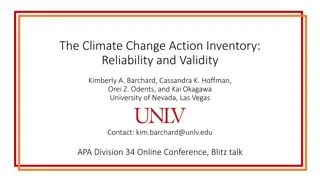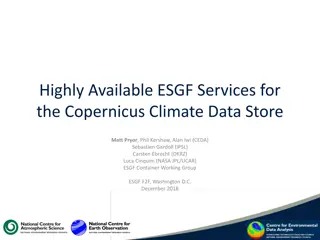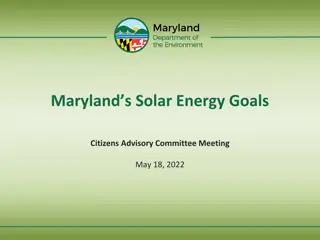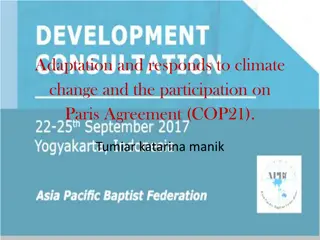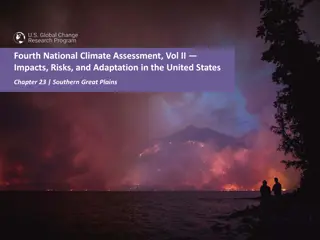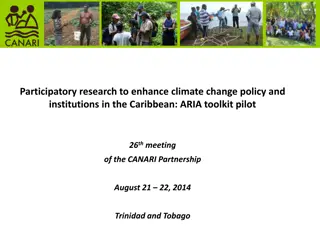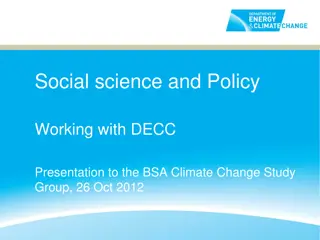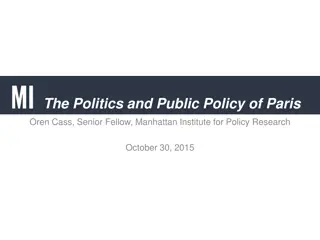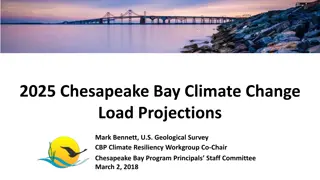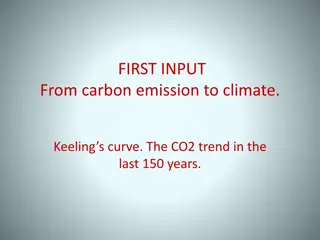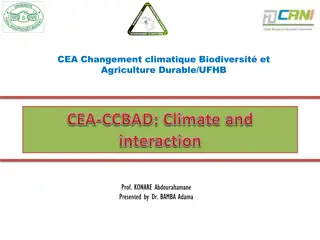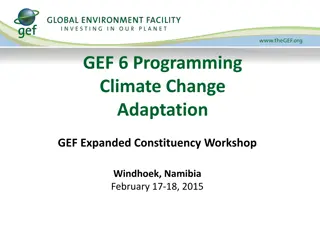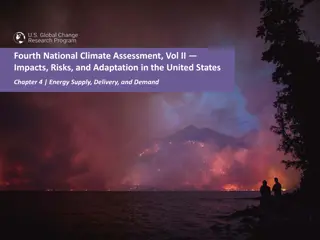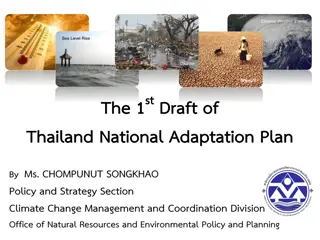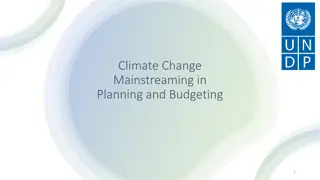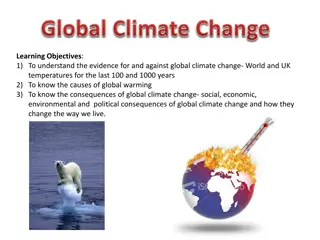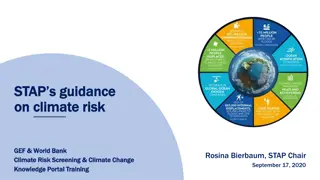Interactions Among Sectors and Complex Systems in Climate Change Assessment
Various sectors like energy, water, agriculture, and financial systems interact with each other, influencing and being influenced by climate-related stressors along with non-climate factors. Understanding these interactions is crucial for assessing and managing the risks posed by climate change, requiring integrated approaches and joint management of systems to enhance resilience and avoid unforeseen consequences.
Download Presentation

Please find below an Image/Link to download the presentation.
The content on the website is provided AS IS for your information and personal use only. It may not be sold, licensed, or shared on other websites without obtaining consent from the author. Download presentation by click this link. If you encounter any issues during the download, it is possible that the publisher has removed the file from their server.
E N D
Presentation Transcript
Fourth National Climate Assessment, Vol II Impacts, Risks, and Adaptation in the United States Chapter 17 | Sector Interactions, Multiple Stressors, and Complex Systems Fourth National Climate Assessment, Vol II Impacts, Risks, and Adaptation in the United States nca2018.globalchange.gov 1
Ch. 17 | Sector Interactions, Multiple Stressors, and Complex Systems Key Message #1 17 Interactions Among Sectors The sectors and systems exposed to climate (for example, energy, water, and agriculture) interact with and depend on one another and other systems less directly exposed to climate (such as the financial sector). In addition, these interacting systems are not only exposed to climate- related stressors such as floods, droughts, and heat waves, they are also subject to a range of non-climate factors, from population movements to economic fluctuations to urban expansion. These interactions can lead to complex behaviors and outcomes that are difficult to predict. It is not possible to fully understand the implications of climate change on the United States without considering the interactions among sectors and their consequences. Fourth National Climate Assessment, Vol II Impacts, Risks, and Adaptation in the United States nca2018.globalchange.gov 2
Ch. 17 | Sector Interactions, Multiple Stressors, and Complex Systems Key Message #2 17 Multisector Risk Assessment Climate change risk assessment benefits from a multisector perspective, encompassing interactions among sectors and both climate and non- climate stressors. Because such interactions and their consequences can be challenging to identify in advance, effectively assessing multisector risks requires tools and approaches that integrate diverse evidence and that consider a wide range of possible outcomes. Fourth National Climate Assessment, Vol II Impacts, Risks, and Adaptation in the United States nca2018.globalchange.gov 3
Ch. 17 | Sector Interactions, Multiple Stressors, and Complex Systems Key Message #3 17 Management of Interacting Systems The joint management of interacting systems can enhance the resilience of communities, industries, and ecosystems to climate-related stressors. For example, during drought events, river operations can be managed to balance water demand for drinking water, navigation, and electricity production. Such integrated approaches can help avoid missed opportunities or unanticipated tradeoffs associated with the implementation of management responses to climate-related stressors. Fourth National Climate Assessment, Vol II Impacts, Risks, and Adaptation in the United States nca2018.globalchange.gov 4
Ch. 17 | Sector Interactions, Multiple Stressors, and Complex Systems Key Message #4 17 Advancing Knowledge Predicting the responses of complex, interdependent systems will depend on developing meaningful models of multiple, diverse systems, including human systems, and methods for characterizing uncertainty. Fourth National Climate Assessment, Vol II Impacts, Risks, and Adaptation in the United States nca2018.globalchange.gov 5
Ch. 17 | Sector Interactions, Multiple Stressors, and Complex Systems Fig. 17.1: Complex Sectoral Interactions Sectors are interacting and interdependent through physical, social, institutional, environmental, and economic linkages. These sectors and the interactions among them are affected by a range of climate- related and non-climate influences. Sources: Pacific Northwest National Laboratory, Arizona State University, and Cornell University. Fourth National Climate Assessment, Vol II Impacts, Risks, and Adaptation in the United States nca2018.globalchange.gov 6
Ch. 17 | Sector Interactions, Multiple Stressors, and Complex Systems Fig. 17.2: Hurricane Harvey Flooding Hurricane Harvey led to widespread flooding and knocked out power to 300,000 customers in Texas in 2017, with cascading effects on critical infrastructure facilities such as hospitals, water and wastewater treatment plants, and refineries. The photo shows Port Arthur, Texas, on August 31, 2017 six days after Hurricane Harvey made landfall along the Gulf Coast. Photo credit: Staff Sgt. Daniel J. Martinez, U.S. Air National Guard. Fourth National Climate Assessment, Vol II Impacts, Risks, and Adaptation in the United States nca2018.globalchange.gov 7
Ch. 17 | Sector Interactions, Multiple Stressors, and Complex Systems Fig. 17.3: Energy Water Land Interactions Energy, water, and land systems are interconnected and impacted by both climate-related and non- climate stressors. These influences affect these systems individually as well as the dynamics among these sectors. A multisector perspective is necessary to understand risks and develop response strategies that enhance resilience across multiple systems. Sources: Pacific Northwest National Laboratory, Arizona State University, and Cornell University. Fourth National Climate Assessment, Vol II Impacts, Risks, and Adaptation in the United States nca2018.globalchange.gov 8
Ch. 17 | Sector Interactions, Multiple Stressors, and Complex Systems Fig. 17.4: Wildfire at the Wildland Urban Interface Wildfires pose significant health and economic impacts through interfaces between wildlands and human settlements. Shown here is a wildfire in the Whiskeytown National Recreation Area in California in August 2004. Photo credit: Carol Jandrall, National Park Service. Fourth National Climate Assessment, Vol II Impacts, Risks, and Adaptation in the United States nca2018.globalchange.gov 9
Ch. 17 | Sector Interactions, Multiple Stressors, and Complex Systems Fig. 17.5: Northeast Blackout During the August 2003 blackout, an estimated 50 million people in Canada and the northeastern United States lost power, with cascading impacts on public health and critical infrastructure. These images show (clockwise from upper left): nighttime satellite imagery of the area before the outage; the same view during the blackout; people walking on the Manhattan Bridge; and passengers being evacuated from a subway train on the Manhattan Bridge during the outage. Image credits: (top) NOAA; (bottom left) Jack Szwergold (CC BY-NC 2.0); (bottom right) Eric Skiff (CC BY-SA 2.0). Fourth National Climate Assessment, Vol II Impacts, Risks, and Adaptation in the United States nca2018.globalchange.gov 10
Ch. 17 | Sector Interactions, Multiple Stressors, and Complex Systems Chapter Author Team 17 Michael Mastrandrea, Carnegie Institute for Science Marilee Orr, U.S. Department of Homeland Security Benjamin L. Preston, Rand Corporation Patrick Reed, Cornell University Ronald D. Sands, U.S. Department of Agriculture Dave D. White, Arizona State University Federal Coordinating Lead Authors Leah Nichols, National Science Foundation Robert Vallario, U.S. Department of Energy Chapter Lead Leon Clarke, Pacific Northwest National Laboratory Chapter Authors Mohamad Hejazi, Pacific Northwest National Laboratory Jill Horing, Pacific Northwest National Laboratory Anthony C. Janetos, Boston University Katharine Mach, Stanford University Review Editor Kai Lee, Williams College (Emeritus) and the Packard Foundation (Retired) Fourth National Climate Assessment, Vol II Impacts, Risks, and Adaptation in the United States nca2018.globalchange.gov 11
Ch. 17 | Sector Interactions, Multiple Stressors, and Complex Systems Acknowledgments 17 USGCRP Coordinators Kristin Lewis, Senior Scientist Natalie Bennett, Adaptation and Assessment Analyst Fourth National Climate Assessment, Vol II Impacts, Risks, and Adaptation in the United States nca2018.globalchange.gov 12
Recommended chapter citation Clarke, L., L. Nichols, R. Vallario, M. Hejazi, J. Horing, A.C. Janetos, K. Mach, M. Mastrandrea, M. Orr, B.L. Preston, P. Reed, R.D. Sands, and D.D. White, 2018: Sector Interactions, Multiple Stressors, and Complex Systems. In Impacts, Risks, and Adaptation in the United States: Fourth National Climate Assessment, Volume II [Reidmiller, D.R., C.W. Avery, D.R. Easterling, K.E. Kunkel, K.L.M. Lewis, T.K. Maycock, and B.C. Stewart (eds.)]. U.S. Global Change Research Program, Washington, DC, USA. doi: 10.7930/NCA4.2018.CH17 Read the full chapter https://nca2018.globalchange.gov/chapter/complex-systems nca2018.globalchange.gov Fourth National Climate Assessment, Vol II Impacts, Risks, and Adaptation in the United States nca2018.globalchange.gov 13








